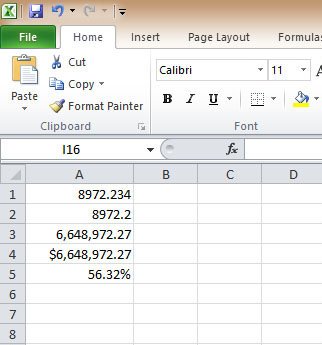The Format function in Excel VBA can display the numeric values in various formats .
There are two types of Format functions, one of them is the built-in Format function while another is the user-defined Format function.
Style argument |
Explanation |
Example |
|
General Number |
To display the number without having separators between
thousands. |
Format(8972.234, “General Number”)=8972.234 |
|
Fixed |
To display the number without having separators between
thousands and rounds it up to two decimal places. |
Format(8972.234, “Fixed”)=8972.23 |
|
Standard |
To display the number with separators or separators between
thousands and rounds it up to two decimal places. |
Format(6648972.265, “Standard”)= 6,648,972.27 |
|
Currency |
To display the number with the dollar sign in front, has
separators between thousands as well as rounding it up to two
decimal places. |
Format(6648972.265, “Currency”)= $6,648,972.27 |
|
Percent |
Converts the number to the percentage form and displays a % sign
and rounds it up to two decimal places. |
Format(0.56324, “Percent”)=56.32 % |
Example 9.1
Private Sub CommandButton1_Click()
Cells(1, 1) = Format(8972.234, "General Number")
Cells(2, 1) = Format(8972.234, "Fixed")
Cells(3, 1) = Format(6648972.265, "Standard")
Cells(4, 1) = Format(6648972.265, "Currency")
Cells(5, 1) = Format(0.56324, "Percent")
End Sub
Although it is known as user-defined format, we still need to follows certain formatting styles. Examples of user-defined formatting style are listed in Table 9.2
Example 9.2
Private Sub CommandButton1_Click()
Cells(1, 1) = Format(781234.57, "0")
Cells(2, 1) = Format(781234.57, "0.0")
Cells(3, 1) = Format(781234.576, "0.00")
Cells(4, 1) = Format(781234.576, "#,##0.00")
Cells(5, 1) = Format(781234.576, "$#,##0.00")
Cells(6, 1) = Format(0.576, "0%")
Cells(7, 1) = Format(0.5768, "0.00%")
End Sub


